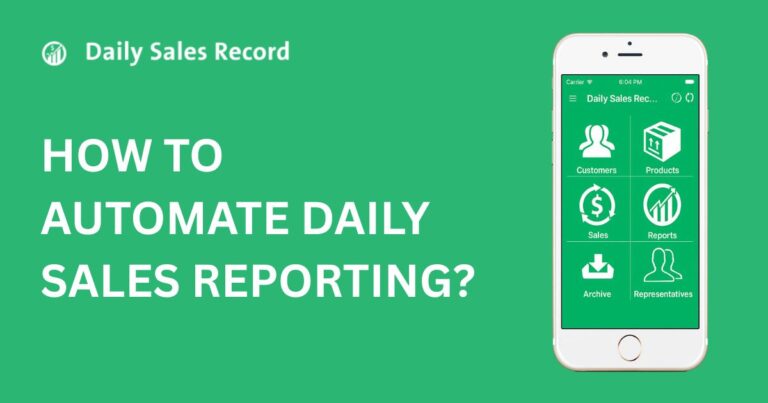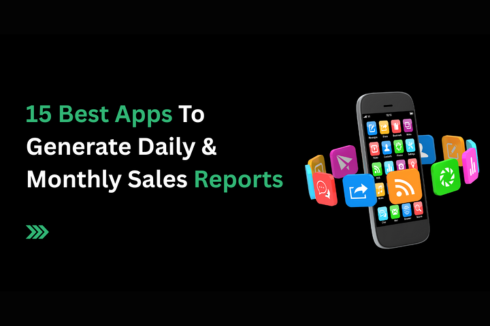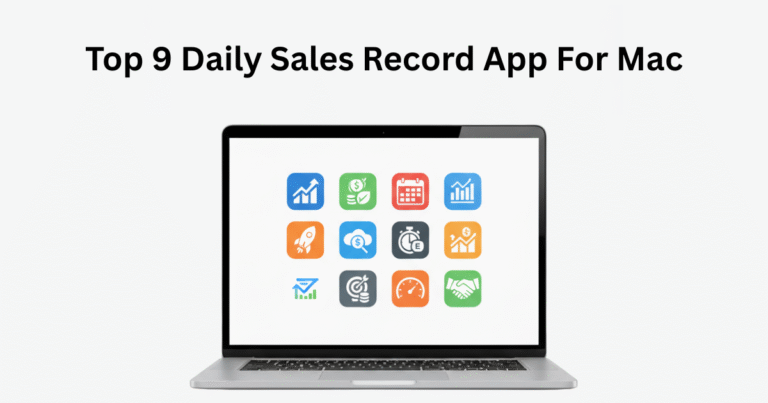12 Best Practices for Sales Tracking to Boost Your Bottom Line
Most of the sales professionals miss their quarterly targets, and poor tracking systems are often the culprit. When revenue goals consistently fall short, the problem lies in the visibility. Without clear insights into pipeline performance and team activities, even the most talented sales teams operate blindfolded.
The most effective sales tracking strategies focus on actionable metrics rather than vanity numbers. Leading sales teams mostly prioritize pipeline velocity over just pipeline size. They track activity quality alongside quantity and monitor customer engagement patterns to predict deal outcomes. Through automated data capturing, they reduce manual entry while improving accuracy.
At Daily Sales Record, we’ve helped hundreds of businesses transform their sales performance through intelligent tracking solutions. Our platform makes it easy to capture sales data and turns it into clear insights, so you can see exactly what’s happening in your pipeline
What Is Sales Tracking?
Sales tracking is the structured process of recording, analyzing, and optimizing every activity that drives revenue.
You use it to monitor emails, calls, meetings, proposals, and customer interactions in real time. By mapping these activities, you gain visibility into buyer behavior, conversion trends, and pipeline health.
This data lets you measure individual and team performance, identify process gaps, and refine strategies with accuracy. With effective tracking, you make decisions based on facts, not assumptions, and drive consistent, predictable sales growth.
Why Proper Sales Tracking is Essential for Every Business
Proper sales tracking transforms assumptions into actionable insights and establishes a foundation for sustainable growth. Here’s why every business needs it:
Clear Funnel Visibility
Tracking offers complete visibility across your entire sales pipeline, from initial prospecting through final closing. You can pinpoint exactly where prospects get stuck, and understand conversion rates between stages. You can find out the weak points in your process.
Performance Accountability
By capturing all sales activities, such as calls made, emails sent, meetings scheduled, you get clear visibility into who’s consistently meeting targets and who might need additional support. You can find out the targeted coaching, realistic goal-setting, and recognition of top performers.
Revenue Attribution
Comprehensive tracking reveals which products, territories, or team members generate the highest returns. When you can connect specific actions to concrete results, resource allocation becomes strategic rather than random. You can double down on profitable opportunities.
Enhanced Customer Relationships
Complete interaction tracking, such as every call, email, and purchase creates a comprehensive customer profile. You can customize the communications precisely, time follow-ups strategically, and address concerns promptly.
12 Best Practices for Sales Tracking to Boost Your Bottom Line
1. Define clear sales stages
As one of the best sales practices, you can define your sales stages with a clear seven-step cycle.
First, find leads using a buyer persona so you know who fits. Next, connect with prospects through personalized outreach that shows value. Then, qualify them by confirming need, budget, and authority before moving forward.
After that, present your solution with data-driven benefits. You must also address objections directly and compare value against alternatives.
Once ready, close with urgency, suggestion, or assumptive strategies. Finally, nurture customers through onboarding and regular check-ins to drive loyalty and repeat growth.
2. Segment your customers for personalized outreach
Yes. Segmenting customers is a core best practice for sales tracking.
When you group buyers by behavior, demographics, or lifecycle stage, your outreach becomes precise instead of generic.
For example, segment new leads into “first-contact” lists and target them with education sequences.
Place high-value accounts in “strategic” segments and send ROI-driven proposals tied to past purchase data. This segmentation inside your tracker keeps outreach focused, improves conversion rates, and drives pipeline momentum.
3. Monitor customer conversations
Monitoring customer conversations is a best practice in sales tracking because it connects interactions to measurable outcomes.
Using call recordings, CRM conversation logs, and structured review tools, you can analyze calls, emails, and chats at scale. Track elements like objection handling, product positioning, and closing signals.
For example,
A software company reviewed recordings of its sales calls to see which arguments worked best. The review showed that mid-market clients responded much better when sales reps highlighted “quick setup with no disruptions.”
Compared to other approaches, this message raised acceptance rates by 25%. The company then updated its sales script, trained new reps with the winning pitch, and tracked deal outcomes. Within a quarter, they saw faster closes and more consistent results across the team.
4. Use CRM software to score leads
Scoring leads in your CRM gives structure to your pipeline. You assign points based on budget, authority, need, and timing. Modern CRMs let you set rules, track engagement, and flag sales-ready prospects automatically. You gain clarity on which leads deserve priority and which need nurturing.
To use it best, define scoring criteria with sales and marketing together. Review the scores monthly and adjust for accuracy. This practice cuts wasted effort, aligns teams, and drives higher conversion rates.
5. Track sales rep activity
Tracking sales rep activity is essential because it links daily actions directly to revenue outcomes. You need more than gut instinct—you need structured data. The most effective method is logging every rep’s calls, meetings, and emails inside a CRM.
Configure the system to time-stamp interactions, tie them to deal stages, and measure response speed. Create activity benchmarks, like “15 calls and 5 demos weekly.”
Use performance dashboards to compare reps, identify delays in deal progression, and coach with concrete evidence. This practice builds accountability, consistency, and growth.
6. Protect data with access controls
Sales tracking only works when your data stays accurate and secure. Sensitive records like lead scores, pipeline forecasts, and deal values must remain visible only to the right people. That’s why role-based permissions in your CRM matter.
You decide who can update lead statuses, edit opportunity stages, or view financial forecasts. When a rep needs wider access, manager approval keeps the process controlled.
Add multi-factor authentication to secure logins, and use audit trails to track changes. These steps protect the integrity of your sales tracking and maintain client confidence
7. Enable mobile access for sales teams
If you haven’t equipped your sales team with mobile access yet, you’re making a costly mistake.
Deals move fast, and without mobile updates, your tracking is always behind. Imagine reps waiting until the evening to log calls or update opportunities.
By then, your pipeline data is outdated, and forecasts lose accuracy. Mobile CRM apps let you capture notes instantly, update lead status on the spot, and review deal progress before the next client meeting. Secure logins and device protections keep data safe.
8. Enhance team collaboration
Working in silos weakens your sales tracking and slows deal progress. You need collaboration to keep your pipeline accurate and moving.
When sales reps, managers, and cross-functional teams share updates in one system, you cut delays and avoid duplicated work.
Use shared CRMs with deal notes, activity logs, and commenting features so everyone has the same view of customer interactions. Add structured check-ins, joint reviews, and coordinated outreach plans. Strong collaboration not only strengthens forecasting accuracy but also drives higher win rates.
9. Use customizable sales pipelines
If your pipeline is rigid, you’re already losing deals. Every business tracks sales differently, so you need pipelines that adapt to your process.
A customizable pipeline lets you add stages that reflect your real workflow, from prospecting through post-purchase. In your CRM, define exit criteria for each stage, such as “budget confirmed” or “proposal shared,” so nothing slips.
Utilize these YouTube instructions for better execution: Optimize Your Sales Pipeline Configuration | Strategic HubSpot Tutorial
Then track deal velocity and stage conversion rates in real time. This structure gives you accuracy in forecasting, visibility into bottlenecks, and control over deal progression.
10. Record and analyze won/lost data
You can’t build strong sales tracking without recording both wins and losses. Start by gathering data in your CRM: deal size, industry, objections, decision-makers, and outcome. Categorize each deal as won or lost, then calculate win and loss rates.
Next, study the causes. Look for repeated buyer objections, competitor strengths, or features that secure wins. Spot patterns across deals to refine your sales playbook. This practice turns raw numbers into insights, helping you forecast better and close more high-value opportunities.
11. Automate lead capture and data entry
Relying on manual entry creates delays and errors that weaken sales tracking. Automating this process ensures speed, accuracy, and consistency. Here’s how you can do it:
- CRM-integrated web forms – Design lead forms on your website or landing pages that connect directly to your CRM. Every submission instantly creates or updates a lead record, eliminating copy-paste errors.
- Email and inquiry parsing – Use parsing tools to capture details from inbound emails or contact forms and map them to CRM fields. This ensures no inquiry goes untracked.
- Marketing automation workflows – Platforms like HubSpot or Marketo can score, route, and enrich leads automatically, saving reps time and giving context for outreach.
- Chatbots and live chat tools – Deploy bots on your site that collect key information during conversations and push it into the CRM in real time.
- Call tracking and logging – Connect your telephony or VoIP system with your CRM so every call, voicemail, and number is logged automatically.
- Data validation and deduplication – Set automation rules to clean, standardize, and merge duplicate records, ensuring your database remains reliable for forecasting.
12. Create a feedback loop & iterate
Continuous improvement is only possible when you systematically capture insights and act on them. Establishing a structured feedback loop helps you refine your sales tracking process and ensure it adapts to changing market dynamics. Here’s how you can implement it:
- Collect structured data – Use your CRM, sales dashboards, and win/loss reports to capture measurable performance data like conversion rates, deal velocity, and stage bottlenecks.
- Incorporate rep feedback – Schedule regular reviews where sales reps share challenges, tool gaps, and customer objections. This qualitative data complements system reports.
- Use customer insights – Gather post-sale feedback through surveys, interviews, or NPS scores to understand why buyers chose—or didn’t choose—your solution.
- Analyze and prioritize patterns – Compare quantitative and qualitative inputs to identify recurring issues (e.g., slow follow-ups, weak demos). Rank them by revenue impact.
- Implement small, testable changes – Adjust scripts, update CRM workflows, or refine lead scoring criteria, then monitor the results against baseline metrics.
- Repeat regularly – Schedule monthly or quarterly reviews to ensure your feedback loop remains active and insights drive consistent iteration.
To Conclude
Strong sales tracking is all about creating structure, clarity, and smarter decisions across every stage of your pipeline.
When you apply the right practices, you remove guesswork, accelerate deals, and uncover opportunities that might otherwise slip away. The difference shows up not just in revenue, but in team confidence and customer trust.
If you’re ready to bring this structure into your business, explore how Daily Sales Record can simplify your tracking and make growth more predictable.
Frequently Asked Questions
Question 1: How often should you review your sales tracking data?
Answer: Review weekly to catch short-term shifts and monthly for broader trends. This balance helps you act quickly without losing sight of long-term goals.
Question 2: Can small businesses benefit from advanced sales tracking practices?
Answer: Yes. Even small teams can track rep activity, deal progress, and conversions. This reduces wasted effort and highlights which strategies drive real growth.
Question 3: What tools are most effective for sales tracking?
Answer: CRM platforms like Salesforce, HubSpot, or Zoho are the most effective. They centralize customer data, automate lead entry, and provide dashboards for accurate reporting.
Question 4: How does sales tracking improve customer relationships?
Answer: Tracking buyer behavior helps you time outreach correctly and personalize offers. This builds stronger trust and encourages repeat purchases.
Question 5: What are the risks of not tracking sales properly?
Answer: Without tracking, you face hidden pipeline bottlenecks, weak forecasting, and unclear rep performance. Over time, this leads to missed revenue and higher customer churn.


